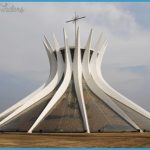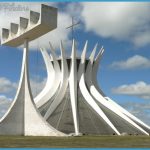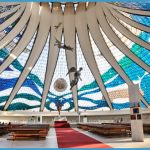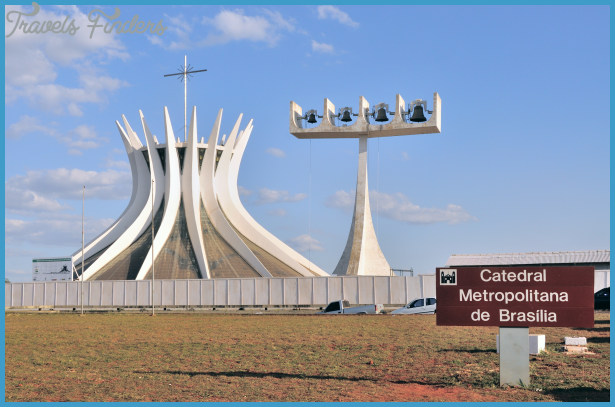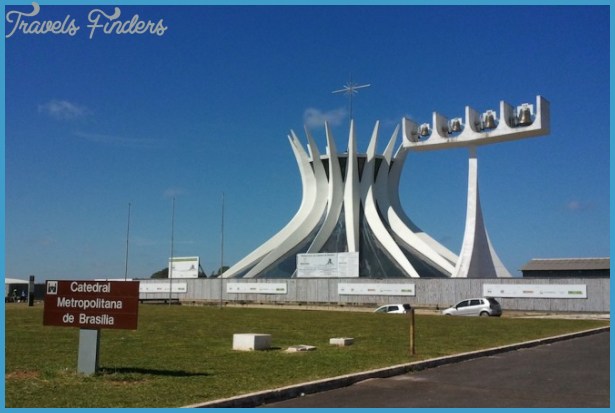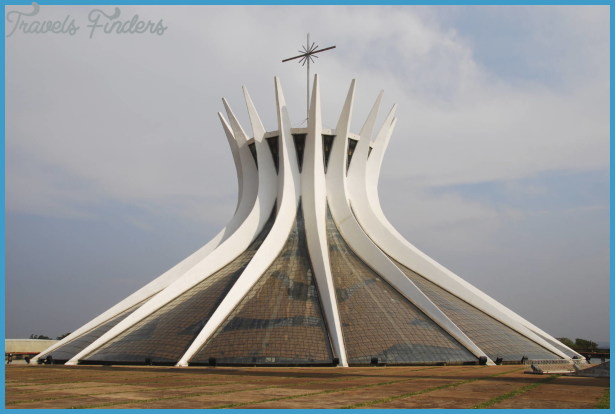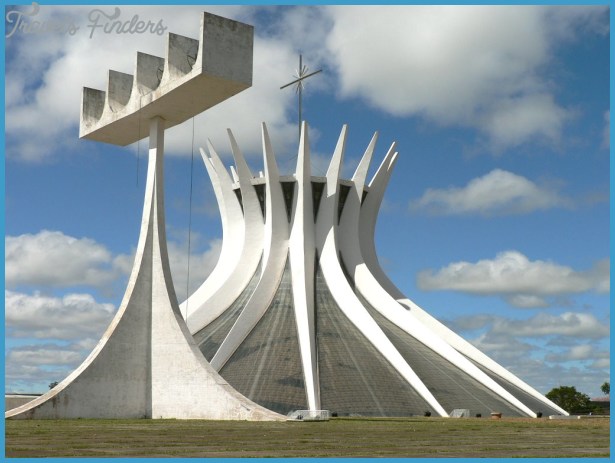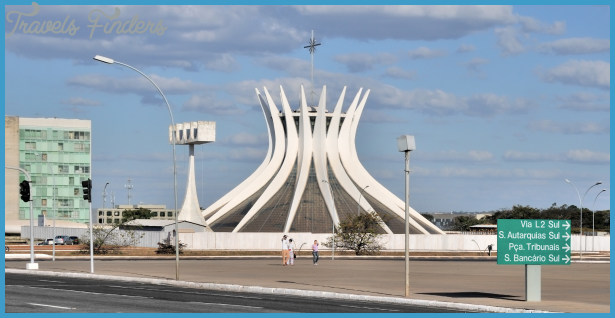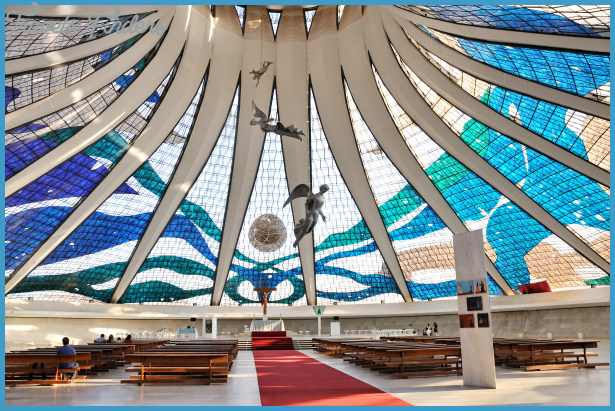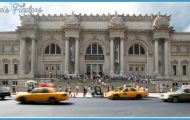COMPLETED 1970 CATHEDRAL BRASILIA, BRAZIL
OSCAR NIEMEYER
Brasilia, the capital of Brazil, was built from scratch in the center of the country in the late 1950s. The principal planner was Lucio Costa, and the lead architect was Oscar Niemeyer, who designed not only many government buildings but also the cathedral in the city center. Niemeyer became a master in the use of concrete to produce sweeping sculptural designs, and the cathedral is an outstanding example.
The cathedral is based on 16 identical concrete columns. Each column weighs 90 tons and stretches, in a flowing hyperboloid curve, from the ground to the top of the building. The columns rise and converge, meeting about two-thirds of the way up before splaying outward and upward, creating a crownlike shape topped with a plain cross.
The spaces between the columns are almost entirely glazed so that, from the outside, the concrete stands out from the neutral glass to create one of the most dramatic forms in modern architecture. The vast expanse of glass ensures that the cathedral’s interior is bathed in light. There is a strong visual play between the columns, which lead the eye upward, and the swirling patterns of blue, green, and brown stained glass, which converge near the high altar on one edge of the interior. The vast floor can accommodate up to 4,000 worshippers.
This awe-inspiring cathedral is rich in symbolism, with its columns soaring into the sky and metaphorically toward heaven, and its interior a three-dimensional representation of the light of Christianity. The building has, however, had its practical problems. The ventilation proved inadequate and the acoustics were faulty-issues that are being addressed. Despite that, the cathedral remains a stunning design, one that helped to win Niemeyer the prestigious Pritzker Prize in 1988, when the citation praised his buildings for the way they distilled “the colors and light and sensual imagery of his native Brazil.
OSCAR NIEMEYER b. 1907
Centenarian Oscar Niemeyer was born in Rio de Janeiro and, after qualifying, worked for the Brazilian architect and planner Lucio Costa. With Costa he designed the new headquarters of Brazil’s Ministry of Education and Public Health (a project on which Le Corbusier was consultant), before working independently on buildings such as the church of St. Francis of Assisi Belo Horizonte, where he developed his flair for curved forms. By the late 1940s he was part of the team designing the new UN headquarters in New York, and his worldwide fame was assured. His work on Brasilia began in the 1950s. As a committed Communist he was exiled from Brazil in the 1960s, after which he worked in Europe and North Africa, returning to Brazil in the 1980s. Still working on architectural and sculptural projects after he reached his 100th birthday in 2007, he has had the longest career of any modern architect.
Visual tour
4 BELL TOWER Like medieval and Renaissance cathedrals in Europe, which sometimes have detached campaniles, Brasilia Cathedral has a separate bell tower positioned a few feet away from the main building. The tower’s main structure is in the same idiom as the cathedral itself, with a single concrete upright tapering to a point at the top. This supports a horizontal concrete beam divided into four sections for the bells, which were donated by Spain.
1 CATHEDRAL ROOF The concrete columns that support the building come to outward-curving points at the top. Here they hold up the concrete disc that forms the central part of the roof. The radiating column tips make the shape of a stylized crown, but they have also been compared to fingers of outstretched hands reaching up toward heaven.
4 INTERIOR The inside of the building consists of a single vast space, about 230ft (70m) in diameter and 246ft (75m) in height. The main architectural feature is the concrete columns. Although large and heavy, they seem light and delicate because they taper toward the floor. The large areas of clear glass between the concrete pillars mean that visitors standing inside the cathedral can look up and see how the columns continue their upward curve on the outside.
2 STAINED GLASS A major element of the cathedral, the stained glass fills the elongated triangles between the concrete columns. The glass was designed by the Franco-Brazilian artist Marianne Peretti, who worked on several of Niemeyer’s buildings. The irregular pieces of glass contrast with the geometrical grid of dark glazing bars.
3 ANGELS Suspended on steel cables, a group of sculpted angels fly beneath the central ceiling disc. The longest of these is 14ft (4.25m) in length, but it does not look its size as it floats in the large space. The angels are the work of sculptors Alfredo Ceschiatti and Dante Croce, and they were installed in 1970.
2 THE HIGH ALTAR This simple white structure was donated by Pope Paul VI. When the cathedral was built, a change in liturgical fashions led some churches to experiment with democratically placed central altars that brought priests and worshippers closer. Although this seemed to work well in round spaces like the one in Brasilia, clergy found that a traditional layout, with the altar at one end or edge, was better, enabling the priest to connect with the whole congregation.
IN CONTEXT
The planning of Brasilia began in 1956 and by 1960 the city was inaugurated as Brazil’s new capital. Niemeyer’s contribution to the city was immense.
He designed most of the main buildings, including the Brazilian Congress, the president’s residence, the deputy’s house, the Palace of Justice, and the National Theater. All are in a modern style, with much use of concrete and glass. Many of them have a sculptural quality, revealing Niemeyer’s delight in the way concrete can be used to build curves, something unusual in modern architecture before this time. The Congress building, for example, has two curved structures, the dome of the Senate and the dish housing the Chamber of Deputies, separated by a more conventional office tower. The Presidential Palace and Supreme Court are rectilinear, but have curved, tapering columns. The National Museum has a white concrete dome. At Brasilia, Niemeyer became a supreme architectural sculptor.
1 Brazilian Congress
With its dome and dish curves, which balance and complement one another as the two legislative chambers are meant to do, the Congress has become one of Niemeyer’s most famous buildings.



